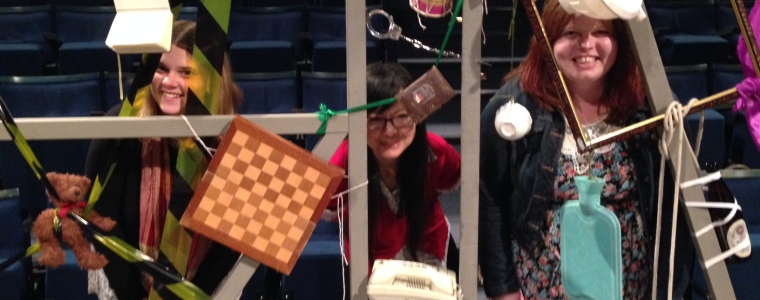It has been a really long time now since I attended a fantasy LARP. Well over a year, and unfortunately my work and personal commitments this year make the outlook bleak. I missed much of last year due to personal and wedding plans, and subsequently I’m a bit out of the loop on what is going on in our ‘finely woven webs of magic and belief’! I hope to attend 2-3 events later in the summer though, so hopefully we will have fabulous LARPing weather!
So this rather explains why the blog has remained in stasis for so long, but there are new entries to come! In this entry in particular, I have recently noticed that this year seems to be shaping up to be the year of controversy over monstering. So, for the non-LARPers out there, monstering is basically being the helpers, crew or bad guys in any given event (see my previous post). Monsters traditionally participate in events for free, and recieve small benefits in return: this is where controversy is emerging, as some events are beginning to request small fees from monsters to secure a place, or promising bigger rewards. There are always concerns for organizers about monsters, for several reasons;
1) monsters are a cost
Most sites have a per-person charge, or a scale of charges based on occupancy, so the price of tickets for players will always be directly or indirectly affected by the size of the monster crew. Even for the rare event which is being held on an open site, public liability insurance charges also scale on a per-person basis (usually at 50 participants, 100 participants, >150 participants basis though this varies). Keeping costs for players low therefore will always rely on having an effective and appropriately sized monster crew.
2) monsters are needed
A good quality event relies on good monsters who are experienced, informed and enthusiastic. Including organizers in the category of ‘crew’ here, it is simply impossible to have an event without them. It is also true, however, that player expectations in fantasy LARP are seen to demand fewer low-activity events where little effect can be made on the world, and more open-world events where players have free choice to engage in different aspects of the plot or storyline. These type of games require more props, bigger sites, and more monsters.
3) are monsters motivated?
Following the above very significant points, most participants (whether players or monsters) know that enthusiasm and contribution to the event can weigh much more than money. An eager monster who finds some great costume in a drawer and brings it along, a group of friends who come along as a group and can work well together to portray a military unit or even someone who gets enthusiastically stuck in to whatever job needs doing (even making the tea!) is an incredible contribution to the success of any event. Motivated monster crews are also important to increasing player numbers, because many people get their first introduction to LARP through monstering an event. Yet this is a completely unpredictable element, which may rely fundamentally on any variety of possible causes, so may be nerve-racking for the organizers! There are little things that organizers try to do to improve motivation, including providing tea, coffee and sweeties, priority bunks, experience for your player character or other incentives, but these often include costs which need to be outweighed by the benefits. And there is always the danger that these incentives might drift into ‘payment’, resembling the feeling of work (see below).
So that explains why organizers might have to deal with conflicting ideas about what monsters should be expected to give or pay, and how much/whether they should be rewarded. Yet there also seems to be a problem for monsters around obligation and enjoyment which overlaps between the hobby and other commitments.
4) How much does it cost?
People volunteering to monster an event may well participate for ‘free’ but may have to pay associated costs of transport, catering, accommodation and equipment. These are the same costs that might be a part of playing the game, but with no guaranteed level or type of enjoyable participation in the game, and less leeway to ‘make your own fun’ these costs may seem more significant.
5) Am I having fun? (is this like work)
As a player, it’s easy to choose your own preferred style of play. Personally, I’ve always enjoyed playing very minor monsters; the squishy one-hit-goblin type who is destined to lose (as monsters are, unlike some amazing one-hit super-goblin players with magic swords I could mention). However if you prefer a competitive playing style, taking on roles where you have no chance of winning is not going to be particularly enjoyable. In addition, many of the other tasks that might be necessary as a crew member can be draining and mundane; too much like hard work rather than fun. Even an unlimited supply of sugar and caffeine can sometimes be a poor substitute for enjoyment.
6) Do I have to be here?
As paper bookings gave way to email and online forums have become wider through social media such as facebook, there is in some ways a stronger sense of a LARP community. But in some places this seems to put a serious (stated or implied) obligation on regular players to participate as monster crew or risk losing their hobby altogether. There is an equally strong tendency to report on events as they happen, emphasising what is sometimes termed FOMO (fear of missing out). Also, a wider reach of advertising about events puts more pressure on players and monsters to attend more events, and increases demand for experienced monster crew (including referees and organizers). This presents monstering as a more serious obligation, as a necessary way to maintain the community, adding a level of pressure which may simply override a decision to participate on other grounds.
These pressures on monsters and event organisers are hardly new. In addition, there have been a number of events in the past which have been so popular to monsters and players alike that these grievances have been shown to be insubstantial. But in the circumstances of rising site costs, rising transport costs, dropping player numbers and more significant ‘real-life’ demands, these problems seem to be getting squeezed from both sides. Of course, this is only a rough summary of debates I have seen elsewhere and I am only adding a little information drawn from wider debates around conditions of economic life in the UK to spice up the discussion.
What has your experience been? As a monster or organizer what is your best experience of an event? Or the worst?
Comments especially welcome to this post!



